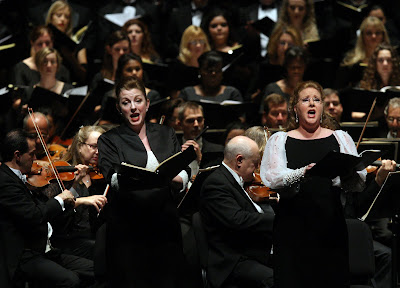 Mezzo-soprano Michaela Martens and soprano Ruth Ann Swenson sing during the finale of Beethoven’s Ninth at the Kravis Center on Friday night.
Mezzo-soprano Michaela Martens and soprano Ruth Ann Swenson sing during the finale of Beethoven’s Ninth at the Kravis Center on Friday night.By Greg Stepanich
Seeing the gigantic forces arrayed on the stage of the Kravis Center, one couldn’t help wondering whether the audience was about to hear a performance of the Mahler Eighth Symphony.
But all those people were there Friday night for Beethoven’s Ninth, which was the season opener this year for the Palm Beach Opera, in lieu of a fourth staged production. With no less than four different choral ensembles joining with the Palm Beach Opera Orchestra and a quartet of veteran operatic soloists, director Bruno Aprea led a Ninth that was notable for its force, emotionality, and rawness, as well as its sheer sonic wallop.
Aprea’s work at the opera has been distinctive for its sense of engagement and discovery; he leads his theatrical forces as though he were advocating for the work at its debut performance. This lends the Italian conductor’s music-making a real feeling of freshness, and that was evident at numerous moments throughout the symphony.
The second-movement Scherzo, for example, was conducted at a fittingly brisk pace, but with a sense of what can only be called swing. Perhaps because the beat was accented a little more emphatically, this familiar music sounded less militaristic and mysterious than it did lyrical and dance-like, and the effect was refreshing.
In the third movement Adagio, Aprea approached the opening theme as a passionate melody, intense and soulful, a departure from a tradition that prefers to treat the four notes of its initial phrase as a serene, nearly static series of slowly unfolding chords. Similarly, the opening repeated fifths of the first movement, so often played almost inaudibly, instead were performed at a distinctly louder volume. These fifths buzzed, they were urgent, and that approach continued throughout the movement: on its toes, ready to dive into action, rather than immense and grandiose.
The orchestra, big as it was, and filled with excellent players, was often ragged through the first three movements, and to some extent in the finale. The solo horn work in the first two movements was an invitation to a clambake, though there was a welcome recovery for the big solo in the third movement, which was lovely. Too often — and this might in part have been due to Aprea’s choreographic baton style — phrases ran into each other rather than finishing, such as in the setup bars before the recapitulation of the Scherzo.
I’d chalk most of it up to short rehearsal time, and I think some of these edges will have been polished up for Sunday’s performance. In any case, things came noticeably together for the finale, which snapped to attention from the opening bitonal yelp.
The soloists — soprano Ruth Ann Swenson, mezzo Michaela Martens, tenor Clifton Forbis and bass Morris Robinson — sang beautifully overall, sounding particularly good as a quartet (more’s the pity that they have relatively little to do in this piece). Robinson sang with the authority that good basses must bring to this music, announcing a change in the proceedings with a huge, rich sound that fit well with the large forces surrounding him.
Forbis sang his Turkish march solo with cutting power and strength, though with some stiffness at the onset. Martens’ pleasing voice blended well with that of Swenson, who handled Beethoven’s difficult higher passages well, especially those treacherous high Bs at the very end. All four musicians showed their professionalism just before that final quartet, when the music almost came apart as Forbis and Robinson, Martens and Swenson, and the orchestra all were coming in at different points for a few scary seconds.
The choral forces, consisting of the Palm Beach Opera Chorus, the Palm Beach Atlantic University Oratorio Chorus, the Masterworks Chorus of the Palm Beaches and the new Robert Sharon Chorale, were gigantic and sang most impressively. This was a chorus in which women and men were balanced; it had enough skilled sopranos to take the Bs of the final verse of the main chorus without squawking, and enough men to sing the Seid umschlungen, Millionen! and be just as stentorian as the trombones and lower strings.
This was a sometimes messy, but quite rewarding, version of Beethoven’s Ninth, and Palm Beach Opera deserves credit for making the best of a dicey economic situation by performing it. If the opera has to do this in subsequent seasons, it’s clear that something even more ambitious could be offered in this setting: the Verdi Requiem, say, or even the Mahler Eighth, which would be hugely difficult, but mark a true milestone for area concertizing.
Bruno Aprea will lead another performance of Beethoven’s Ninth Symphony with the same forces at 2 p.m. Sunday at the Kravis Center. Tickets range from $20-$80 and are available through the Kravis Center box office at 832-7469 or www.kravis.org. The Palm Beach Opera’s first staged production, Verdi’s Otello, is set for Jan. 22-25 and features Carl Tanner as the Moor and Sabina Cvilak as Desdemona. For more information, call 833-7888 or visit www.pbopera.org.


